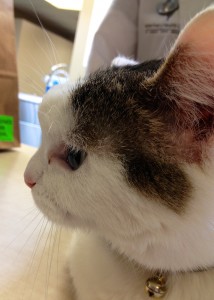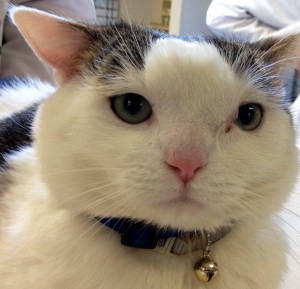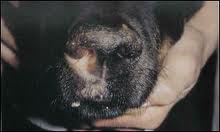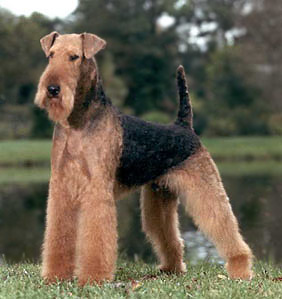No one likes having a stuffy nose. It can be uncomfortable and frustrating. One may not even be able to taste food appropriately or at all. Simply it can be quite miserable! So too is the feeling for a dog or cat with nasal congestion. Now imagine having a horribly stuffed nose for weeks on end. Unfortunately chronic nasal disease occurs frequently in pets, and in my experience, many pet parents don’t adequately know all that can be done for affected animals.
In this week’s post, I will review the clinical signs and common causes of chronic nasal disease, as well as tests potentially used in the diagnostic process. Next week I will discuss treatment of chronic nasal diseases in dogs and cats.
Chronic nasal disease clinical signs…
Two of the most common clinical signs observed in pets living with chronic nasal disease are sneezing and nasal discharge. Other possible signs include:
- Eye discharge
- Stertor, an abnormal noise from the nose
- Lethargy
- Reduced appetite
- Deformity of the nose


Note the protrusion and asymmetrical swelling of the region between the eyes in this cat with nasal lymphoma
- Epistaxis (nose bleed)
- Depigmentation of the nose
- Ulceration of the nose
Chronic nasal disease causes…
Understandably there are multiple potential causes of chronic nasal disease in dogs and cats. To facilitate our discussion, I have divided them into some major categories, including:
Infectious diseases: Infectious diseases include bacteria, fungal organisms, viruses, and parasites. Bacteria normally live in the nose, and primary bacterial infections are exceedingly rare; however bacterial infections that occur as a result of another problem (i.e.: a cancer, previous trauma that changed nose anatomy) are common – this is called a secondary bacterial infection. Other frequently encountered infectious diseases can be found in Table 1 and Table 2.
| Table #1: Common Infectious Causes of Nasal Disease in Dogs |
| Fungi: Aspergillus fumigatus, Penicillium spp., Rhinosporidium seeberi |
| Viruses: Parainfluenza virus, Canine distemper virus, Canine adenovirus 2, Canine herpes virus, Canine coronavirus |
| Bacteria: Bordetella bronchiseptica, Mycoplasma spp., Streptococcus zooepidemicus |
| Parasites: Pneumonyssoides caninum, Eucoleus boehmi |
| Table 2: Common Infectious Causes of Nasal Disease in Cats |
| Fungi: Cryptococcus neoformans, Aspergillus spp., Penicillium spp. |
| Viruses: Feline herpes virus I, Calicivirus |
| Bacteria: Bordetella bronchiseptica, Mycoplasma spp., Chlamydophyla spp., Actinomyces spp., Haemophilus spp., Capnocytophaga spp., Bartonella spp. |
| Protozoa: Toxoplasma gondii |
Any factor that contributes to alterations in the structure or function of the nasal passages will compromise normal function and predispose to chronic damage. Thus nasal trauma, congenital and conformational changes, periodontal disease and foreign bodies all predispose a pet to chronic infection.
Chronic inflammation / allergies: In cats chronic nasal inflammation (called rhinitis) can be documented at any time after six months of age. Previous studies demonstrated feline herpes virus I can destroy cartilage (called turbinates) in the nasal cavity; many believe the clinical signs observed in cats are related to an irreversible destructive process within the nasal cavity that allows secondary bacterial infection and subsequent inflammation.
In dogs the definitive cause of chronic rhinitis is currently unknown. We suspect the chronic inflammation is triggered by an inhaled allergen or irritant. Hypersensitivity to native commensal organisms within the nose may also play a role in some patients. Chronic inflammation may be present with other chronic nasal diseases, and thus it is imperative to perform a complete diagnostic investigation.
Cancer: Nasal and sinus tumors represent ~60-80% of all respiratory tract tumors in dogs, but are observed less frequently in cats. The majority of nasal tumors are cancerous, and while they are primarily locally invasive, they infrequently metastasize or spread to other sites (rate of metastasis at presentation ranges from 0-12.5%). There is no consistent sex predilection in dogs or cats, but most pets with nasal cancer are older (median age is 10 years of age for dogs and 8-10 years of age for cats). The most common nasal tumors in dogs and cats are listed in Table 3.
| Table 3: Common Cancers of the Nasal Cavity in Dogs & Cats | |
| Dogs | Cats |
| Carcinoma, Adenocarcinoma, Fibrosarcoma, Chondrosarcoma, Osteosarcoma, Lymphoma | Lymphoma, Squamous cell carcinoma, Adenocarcinoma |
In dogs the risk of nasal cancer appears to correlate with the amount of surface area in the nasal passages and the efficiency of the filtering capability. Dolichocephalic (long-nosed) and mesaticephalic (intermediate length-nosed) dogs have a higher risk of nasal cancer while brachycephalic dogs (short-nosed) have a lower risk of developing a nasal malignancy. Breeds documented to have an increased risk of developing nasal cancer include:
- Airedale terriers
- Basset hounds
- Old English sheepdogs
- Scottish terriers
- Collies
- Shetland sheepdogs
- German shorthair pointers
Mixed breed dogs appear to have an equal risk of developing nasal cancer as purebred ones, suggesting a possible environmental influence. Exposure to environmental tobacco smoke, indoor kerosene or coal combustion, as well as the use of flea spray have all been associated with an increased risk of nasal cancer in dogs.
In cats chronic rhinitis may be an initiating factor for the subsequent development of nasal cancer. Nasal lymphoma has been reported in cats with and without feline leukemia virus.
Chronic nasal congestion diagnostic testing…
As is true for all medical and surgical conditions, the two best diagnostic tests are always a complete patient history and a thorough physical examination. The information gained from these tests unquestionably shapes a veterinarian’s recommendations for further diagnostic investigation. Some additional commonly recommended tests for dogs and cats with chronic nasal disease are:
Infectious disease screening: In dogs and particularly cats, appropriate screening for a possible infectious cause is of paramount importance. Depending on the part of the United States in which one lives, testing for the fungus, Aspergillus fumigatus, may be appropriate. Screening for viral infections, as well as Cryptococcus neoformans and Toxoplasmosis gondii, should be strongly considered in cats.
Diagnostic imaging: Several different imaging modalities may be helpful when looking for a definitive cause of chronic nasal clinical signs. Most commonly radiographs (x-rays) of the skull are performed at first opinion veterinary hospitals. To obtain images of potential diagnostic quality, pets must be briefly sedated to allow for proper positioning. Unfortunately radiographs rarely provide a definitive diagnosis, and advanced imaging is often needed. Specifically computed tomography (CT scan) provides unique information about the nature and invasiveness of the underlying disease process; additionally the images obtained from a CT scan can be used by surgical and/or oncology teams should that type of intervention be subsequently indicated and recommended.
Advanced imaging procedures like CT scans and magnetic resonance imaging (MRI) are performed at veterinary specialty hospitals, as primary care veterinarians do not often have the capability to perform such imaging tests at their respective hospitals.
Rhinoscopy: Rhinoscopy is a procedure during which a veterinarian uses a specialized fibre-optic camera to look deeply inside each nostril. The images obtained are diagnostically invaluable, providing additional information about the extensiveness of damage present. As I have discussed in other posts, any veterinarian with enough money can buy specialized diagnostic equipment; purchasing a rhinoscope is not restricted to board-certified veterinary specialists. However one can’t purchase clinical experience conducting rhinoscopic examinations, and this experience is truly invaluable when accurately performing rhinoscopy and interpreting images. Click here to watch of a video of rhinoscopy in a dog.
Biopsy: If an infectious disease is not identified in a pet’s diagnostic investigative process, a biopsy from inside the nose is absolutely necessary to obtain a definitive diagnosis. There are multiple ways of obtaining tissue samples from the nasal passages, particularly via rhinoscopy, surgery, and blindly with anatomic references. The most appropriate modality by which to obtain a biopsy depends on many variables and is uniquely patient dependent.
As you can see, the investigative process for a pet living with chronic nasal congestion can be complicated and often requires specialized equipment. For this reason, consultation with a board-certified veterinary internal medicine specialist is often recommended and can be uniquely invaluable.
The take-away message from Part I…
Chronic nasal diseases are relatively common in dogs and cats. Affected pets are congested and often have discharge from their noses. They commonly sneeze, make abnormal respiratory noises, and may even develop facial deformities. Possible causes include infectious diseases, cancers, and allergies. A thorough diagnostic investigation is recommended to ensure treatment can be tailored to maximize the likelihood of a meaningful response. Partnering with a board-certified veterinary internal medicine specialist can be truly beneficial to ensure the most appropriate tests are performed properly. Please be sure to come back next week for Part II in which I will discuss treatment of chronic nasal diseases in dogs and cats!
To find a board-certified veterinary internal medicine specialist, please visit the American College of Veterinary Internal Medicine.
To find a board-certified veterinary emergency and critical care specialist, please visit the American College of Veterinary Emergency and Critical Care.
Wishing you wet-nosed kisses,
cgb




